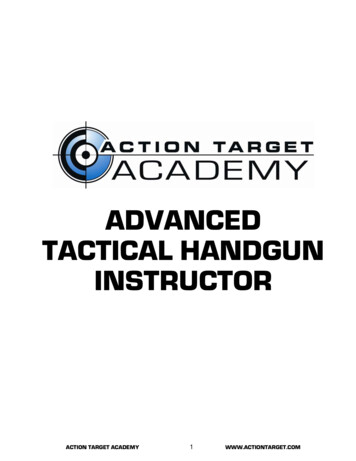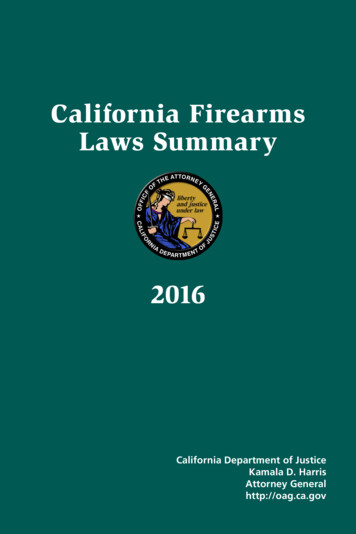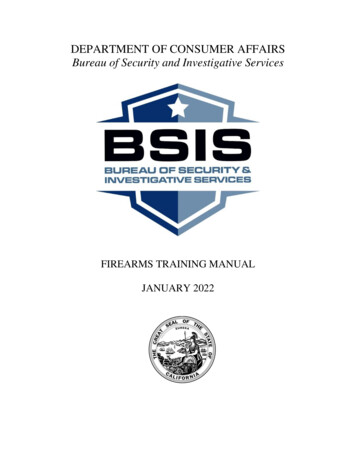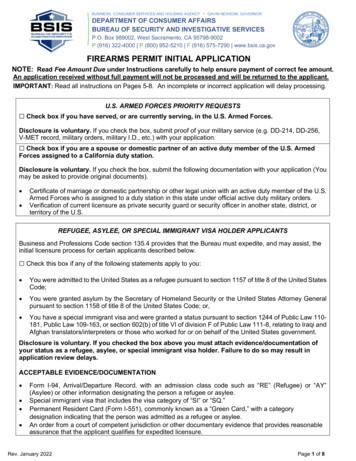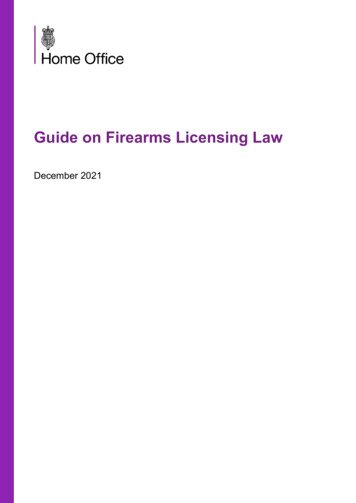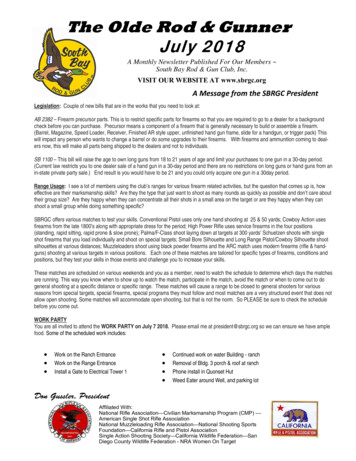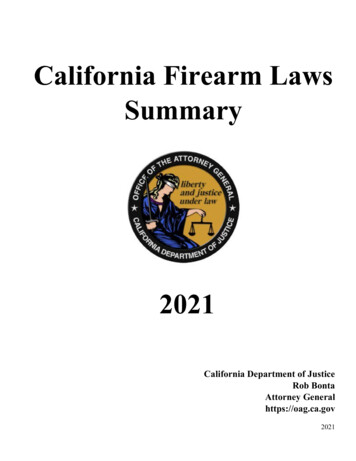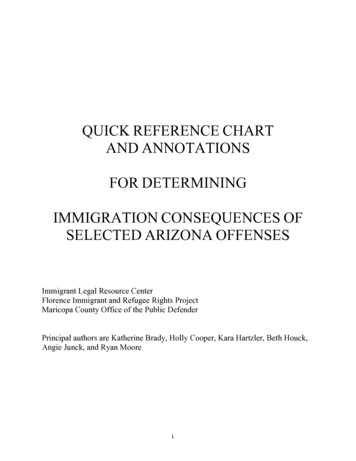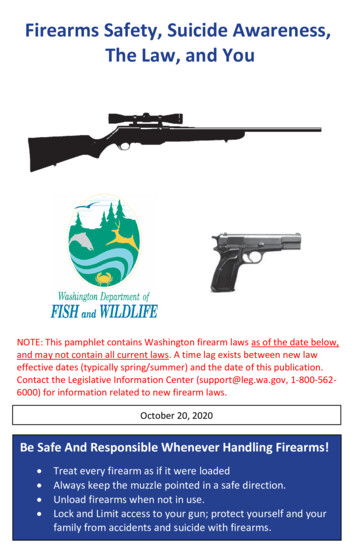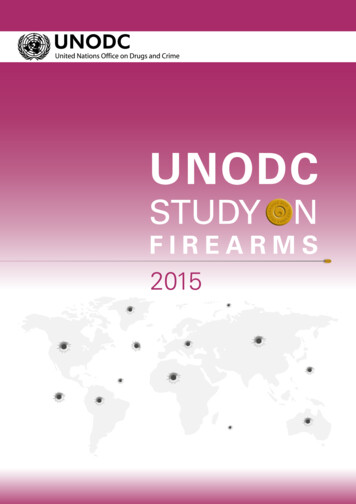
Transcription
UNODC5F I RE AROG A MSTUDY ONME 201SRM PRFIREARMS2015
UNITED NATIONS OFFICE ON DRUGS AND CRIMEViennaUNODCSTUDY ON FIREARMS 2015A study on the transnational nature of and routes andmodus operandi used in trafficking in firearms
Copyright 2015 United Nations Office on Drugs and Crime (UNODC)This publication may be reproduced in whole or in part and in any form for educational or non-profit purposeswithout special permission from the copy-right holder, provided acknowledgment of the source is made. UNODC would appreciate receiving a copy of any publication that uses this publication as a source.DISCLAIMERSThis Global Study on Firearms has not been formally edited.The contents of this publication do not necessarily reflect the views or policies of UNODC or contributoryorganizations, nor do they imply any endorsement.The designations employed and the presentation of the material in this publication do not imply the expressionof any opinion whatsoever on the part of UNODC or the Secretariat of the United Nations concerning the legalstatus of any country, territory, city or area or of its authorities, or concerning the delimitation of its frontiersor boundaries.
CONTENTSCONTENTSME 201FIREASRM PR5OGRA MCONTENTSACKNOWLEDGMENTSVEXECUTIVE SUMMARYVIIABBREVIATIONS AND ACRONYMSINTRODUCTIONXIXIIICHAPTER ONE: THE UNODC STUDY ON FIREARMS: FRAMING THE ISSUE 1A. Global demand for and supply of firearms 1B. Coverage of the Study 3CHAPTER TWO: OVERVIEW OF SEIZURE DATA5A. What is a seizure? 5B. Annual firearm seizures 8C. Firearm seizures by populationD. Type of seized firearms 14E. Seizures of parts and components 23F. Seizures of firearms ammunition 26G. Conclusion: a basis for better policy-making 28CHAPTER THREE: INSIGHTS INTO TRAFFICKING IN FIREARMS29A. What is illicit trafficking in firearms, their parts and components and ammunition?. 29B. From seizures to trafficking 30C. Domestic and international cooperation in tracing 33D. Routes, modus operandi, and identity of firearms traffickers 36E. Conclusion: the distinctive features of firearms trafficking 63I
MIR4 F ERMS PRAM 201UNODC STUDY on Firearms 2015OGR ACHAPTER FOUR: IMPLICATIONS FOR EFFORTS TO COUNTERILLICIT FIREARMS TRAFFICKING65CONCLUSIONS73A. Data collection and monitoring challenges 65B. Overcoming national challenges to countering illicit firearms trafficking 66C. International responses to trafficking in firearms 66D. Addressing the challenges through technical assistance 69ANNEXESREFERENCE MATERIAL771. BASICS OF FIREARMS 77A. Basic definitions 77B. Common types of firearms 79C. Ammunition 832. MONITORING TRAFFICKING IN FIREARMS, THEIR PARTS ANDCOMPONENTS AND AMMUNITION: METHODOLOGICAL ASPECTS 85A. Methodology 853. MULTILATERAL AND REGIONAL INSTRUMENTS AND DOCUMENTS 894. BIBLIOGRAPHY AND REFERENCES 955. SEIZURE QUESTIONNAIRES 99STATISTICAL ANNEX1016. COUNTRY RESPONSES TO UNODC QUESTIONNAIRES 1047. FIREARM SEIZURES BY YEAR 1078. TYPES OF SEIZED FIREARMS 1149. MAKE OF SEIZED FIREARMS 13310. ITEMS RELATED TO SEIZED FIREARMS 137TEXT BOXESBox 1Box 2Box 3Box 4Box 5World Customs Organization Customs Enforcement Network Reports 7Tracing of firearms: a tool against trafficking 33Re-activated firearms 43Case study of intraregional trafficking: the former Yugoslav Republic of Macedonia 50Model Law against the Illicit Manufacturing of and Trafficking in Firearms,Their Parts and Components and Ammunition 70Box 6 Firearms Protocol definition of a firearm 77Box 7 1997 Panel of Governmental Experts on Small Arms 78TABLESTab. 1 Number of firearms reported seized by police, 2010-2013.9Tab. 2 Number of firearms reported seized by customs, 2010-2013.11Tab. 3 Annual rates of firearms reported seized by police per 100,000 residents, 2010-2013, by country.12Tab. 4 Annual rates of firearms seized by customs per 100,000 residents, 2010-2013, by country.13Tab. 5 Types of firearms reported seized by police, absolute counts, 2010-2013, by country .18Tab. 6 Types of firearms reported seized by customs, absolute counts, 2010-2013.22Tab. 7 Parts and components of firearms reported seized by police, absolute counts, 2010-13.25Tab. 8 Parts and components of firearms reported seized by customs, absolute counts, 2010-2013.25Tab. 9 Rounds of ammunition reported seized by police, absolute counts, 2010-2013, by country.26Tab. 10 Ammunition seized by customs, absolute counts, 2010-2013.27II
CONTENTSTab. 11Tab. 12Tab. 13Tab. 14Tab. 15Tab. 16Tab. 17Tab. 18Tab. 19Tab. 20Tab. 21Tab. 22Tab. 23Tab. 24Tab. 25Tab. 26Data reporting on trafficking in firearms, by country, 2010-2013. 31Qualitative reporting on trafficking, 2010-2013. 32Summary of reported international requests for tracing of firearms, 2010-2013. 34Origin of reported seized firearms, 2010-2013. 37Origin of seized firearms, in per cent, 2010-2013. 39Reported countries of manufacture of seized firearms and ammunition, in per cent, 2010-2013.40R eported countries of manufacture of seized firearms and ammunition,without quantity or percentage, 2010-2013 . 44Reported country of departure of seized firearms and ammunition, in per cent, 2010-2013. 45R eported countries of departure of seized firearms and ammunition,without quantity or percentage, 2010-2013. 47R eported countries of intended destination for seized firearms and ammunition,in per cent, 2010-2013.48R eported countries of intended destination for seized firearms and ammunition,without quantity or percentage, 2010-2013. 50Proportion of reported seizures by means of transportation, in per cent, 2010-2013. 55Reported seizures by means of transportation, absolute counts, 2010-2013 . 57Most frequent offences reportedly associated with seized firearms, 2013 (or latest available year). 58Accused firearms traffickers identified as citizens of the seizing country, in per cent, 2010-2013. 59Accused firearms traffickers identified as citizens of foreign countries, 2010-2013. 60FIGURESFig. 1 Proportion of global firearms ownership . 1Fig. 2 Selected examples of trends in firearms seizures reported by police,absolute numbers seized in each year, 2010-2013 (except for Argentina). 10Fig. 3 Trends in firearms seizures reported by police, the former Yugoslav Republic of Macedonia,2010-2013. 11Fig. 4 Types of firearms seized, absolute counts, Turkey, 2010-2013. 17Fig. 5 Types of firearms seized, absolute counts, Montenegro, 2010-2013. 17Fig. 6 Types of firearms reported seized by police, as percentage of the total, selected examples . 21Fig. 7 Types of firearms reported seized by police, as percentage of the total, Ghana and Peru .23Fig. 8 Types of parts and components reported seized by police,as percentage of the total, Turkey and Greece . 24Fig. 9 Examples of trends in firearms ammunition reported seized by police,Ghana and Latvia, absolute counts, 2010-2013. 27Fig. 10 Amount of seized firearms identified and, whenever possible,traced back to the country of manufacture, 2013 or latest available year. 39Fig. 11 Trafficking routes identified by reporting authorities, Ecuador. 51Fig. 12 Trafficking routes identified by reporting authorities, Estonia. 52Fig. 13 Trafficking routes identified by reporting authorities, Ghana. 53Fig. 14 Trafficking routes identified by reporting authorities, Romania . 54Fig. 15 Citizenship of identified traffickers, the former Yugoslav Republic of Macedonia, 2011. 62Fig. 16 Citizenship of identified traffickers, Estonia, 2011. 62Fig. 17 Citizenship of identified traffickers, Brazil, 2013. 62Fig. 18 Citizenship of identified traffickers, Turkey, 2013. 63Fig. 19 Status of ratification of the Firearms Protocol. 67Fig. 20 Common types of firearms. 79Fig. 21 Craft weapons. 81Fig. 22 Parts and components of a pistol . 82Fig. 23 A cartridge and its elements. 83MAPSMap 1: Countries covered by this Study. 4Map 2: Firearm border crossing points reported by Romanian authorities. 38Map 3: Status of ratification of the Firearms Protocol (as of 20 May 2015).68III
MIR4 F EOGR AIVRMS PRAM 201UNODC STUDY on Firearms 2015
ACKNOWLEDGMENTSACKNOWLEDGMENTSME 201FIREARA MCore TeamResearch coordinationSimonetta Grassi, Head of the Global Firearms ProgrammePrincipal authors (in alphabetical order)Aaron Karp, Nicholas Marsh, Giorgio RavagliSubstantive contributions and support:Diman Dimov, Yasmin Espinoza, Lucia GomezConsoli, Ishtiaq Khan, Jacques Ndour Seckene, HildaOlivia Sarkissian and Andrew Smith, and the internsBernabe Larrotcha, Jesus Morales, Victoria Perotti andKatherine Vergara Gonzalez.Review and commentsGuidance and advice was provided by the Research andTrend Analysis Branch. The Global Firearms Programmewishes to thank in particular Angela Me (Chief RAB) andher team.The Global Firearms Programme is also grateful forthe valuable advice and feedback provided by the following experts: Anna Alvazzi del Frate, Nicolas Florquin, Pierre Go-binet, Owen Green, Benjamin Kingand Matt Schroeder.IT DevelopmentFrancisco Diaz Navarro and Farayi Nyamadazawo (Information Technology Service UNODC)OGThe UNODC Study on Firearms was prepared by the Global Firearms Programme (GFP) of the ImplementationSupport Section (ISS), Organized Crime and Illicit Trafficking Branch (OCB), Division for Treaty Affairs (DTA)under the overall supervision of Dimitri Vlassis, OiC Director DTA, and Loide Lungameni, Chief of OCB.SRM PR5MappingUmidjon Rahmonberdiev (DPA/RAB)EditingStephanie LovellGraphic design & printingJoerg Kollegger, Lightpainting StudiosNational and International PartnersThis Study is the result of a broad participatory processinvolving many Member States which contributed toand supported its development. Special thanks go tothe national focal points who have worked closely withthe Study team and coordinated the collection and submission of the data and other relevant material.The Global Firearms Programme wishes also to acknowledge the cooperation of other international organizations, Governments and research institutionswhich have provided information, pictures, feedbackand expertise during the development process of theStudy. Particular thanks to (in alphabetical order):Marcus Vinicius Dantas, Federal Police Commissioner.Federal Police Directorate for the Combat of OrganizedCrime, Federal Police of Brazil; Matias Molle, Director,National Registry of Arms and Explosives, Republic ofArgentina; Francois Remue, World Customs Organization (WCO); Mauro Silvis, National Association ofArms and Ammunition Manufacturers, Italy. JeffreyStirling, Firearms Programme, International CriminalPolice Organization (INTERPOL)The present Study was partially funded by the European Union and by Japan through their contributions to the Global Firearms Programme.V
MIR4 F EOGR AVIRMS PRAM 201UNODC STUDY on Firearms 2015
EXECUTIVE SUMMARYEXECUTIVE SUMMARYThe United Nations Office on Drugs and Crime(UNODC) Study on Firearms employs a pioneering data-focused approach to the study of trafficking in firearms, their parts and componentsand ammunition. Based on information from 45countries, it examines the quantities and types offirearms seized in different regions, the routes andmethods used in the trafficking of firearms andother offences associated with reported seizures.Background and mandateThe UNODC Study on Firearms was developedpursuant to resolutions 5/4 and 6/2 of the Conference of the Parties to the United Nations Convention against Transnational Organized Crime,1which mandated UNODC “to conduct a study ofthe transnational nature of and routes used in trafficking in firearms, based on the analysis of information provided by States on confiscated weaponsand ammunition” (para. 7, Conference resolution5/4). The Conference tasked UNODC to carryout the study in close collaboration with nationalauthorities and to base it on official informationprovided by States on seized firearms, their partsand components and ammunition.Scope and objectives of the StudyThe Study was developed to raise global knowledgeon illicit trafficking in firearms, including its transnational nature and the routes and modus operandi used, by enhancing understanding of this phenomenon and its links to other serious crimes. TheStudy is the first of its kind and all Member Stateswere invited “to participate in and contribute to it asappropriate” (para. 7, Conference resolution 6/2). Itlays the foundation for further research at the international level on trafficking in firearms.2 One of theprimary objectives was to demonstrate the importance of data collection and analysis on trafficking infirearms and, consequently, highlight the usefulnessof monitoring illicit firearms trafficking flows at thenational, regional and international levels.This Study demonstrates the importance of continuing efforts to enhance national systems forcollection and analysis of detailed data on illicitfirearms trafficking. It is a demonstration of thepotential future value of improved national systems to collect data and international cooperationin collating and analysing that data.1United Nations, Treaty Series, vol. 2225, No. 39574. The Convention was adopted in December 2000 and entered into force in 2003.185 State Parties have so far ratified or acceded to it.2The background paper entitled “Challenges and good practices in countering illicit manufacturing of and trafficking in firearms, theirparts and components and ammunition, and measures to facilitate the implementation of the Protocol against the Illicit Manufacturing ofand Trafficking in Firearms, Their Parts and Components and Ammunition, supplementing the United Nations Convention against Transnational Organized Crime” (CTOC/COP/WG.6/2014/2) provides further information on the relevance of monitoring illicit traffickingflows, the objectives and methodological aspects of the Study, the challenges and good practices in facilitating States’ participation in theStudy, as well as the progress of UNODC in the development of the Study.VII
MIR4 F ERMS PRAM 201UNODC STUDY on Firearms 2015OGR AGuiding principles and methodologyOverview of seizure informationThe Study is based primarily on country responses to twoquestionnaires, designed and circulated by UNODC:Data on aggregated national seizures is presented inChapter 2. The data was reported by 39 countries, 37of which provided data compiled by the police andtwo of which provided data compiled by customs.The seizure reports supplied by countries for this Study give a unique view of the scale and dimensions ofillicit trafficking in firearms, their parts and components and ammunition. The key findings from theinformation provided by responding countries show: The annual seizures report questionnaire, askingprimarily for aggregate data on firearms, theirparts and components and ammunition seizedduring 2010-2013 The significant seizures report questionnaire, askingprimarily for detailed information about significantindividual incidents related to trafficking seizures.In this Study, the two data sources are used differentlyin order to reflect their respective strengths. The twoquestionnaires were intended to elicit two differentsets of information related to seized firearms, theirparts and components and ammunition in respondingcountries. Each questionnaire addresses seizures andthen elicits quantitative and qualitative informationrelevant to illicit trafficking in firearms, their parts andcomponents and ammunition.Outcome of the StudyThe Study shows the value and usefulness of information related to firearms and ammunition seizures interms of forming a better understanding of the transnational nature of and routes used in trafficking in firearms. It focuses on individual country results ratherthan on totals and to better reflect the participationand efforts of all responding countries.Participation in the study was voluntary. Forty-eightcountries responded directly to UNODC and provided information related to firearms seizures or trafficking. Of those countries, 42 were States parties tothe Protocol against the Illicit Manufacturing of andTrafficking in Firearms, Their Parts and Componentsand Ammunition, supplementing the United NationsConvention against Transnational Organized Crime,3one was a signatory (Germany) and five were non-States parties (Colombia, France, Niger, Russian Federation and Zimbabwe). Additionally, information fromtwo countries (Costa Rica, and Serbia) was collectedthrough publicly available official data. However, notall the information was equally comparable for analytical purposes and could not always be utilized forthe Study. As a result, the Study’s findings are basedon information from 45 countries. Latin America andEurope were the most represented regions, followedby West Africa.3VIII Large differences in the levels of reported seizuresbetween countries, with some countries reportingdozens of seized firearms per year and others reporting tens of thousands. The annual reported seizures of firearms and ammunition within individual countries were highlyvolatile, with some countries reporting exponential variations from one year to the next. The degree of such differences and variations isdue to a variety of issues, including different reporting practices, contingent seizure incidents,and trafficking situations in each country; as such,it is an important subject for further investigation. The existence of differences in reporting practicespoints to the need for more standardized andcomprehensive reporting of seizures. Among the 35 countries that reported breakdowns by type of seized firearm, the most commonly reported types seized were handguns (pistols and revolvers), accounting for 53 per cent ofall reported seizures. Rudimentary firearms, which are crude gunsmade by artisans, were not found in most countries that reported data or accounted for a smallproportion (less than 5 per cent) of reported firearms seizures. Nevertheless, they were muchmore frequently found in the reported seizures ofseveral countries, including Burkina Faso, Ecuador, Ghana, Peru and Trinidad and Tobago.While the seizure data examined in Chapter 2 revealsa great deal about seized firearms and certain aspectsrelated to trafficking, they also point to the importance of further international data collection and independent evaluation of the available information.While a general sense of scale and typical variationsUnited Nations, Treaty Series, vol. 2326, p. 208-308, 2001. So far 113 States have ratified or acceded to the Protocol.
EXECUTIVE SUMMARYcan already be determined, the implications for policymaking will be clearer once data has been collectedover a longer period and there are more comprehensive seizure reports and background information aboutthe legal context of a seizure.Overview of trafficking informationInformation on trafficking indicators was provided by30 countries, of which five were from Africa, 14 fromEurope and 11 from Latin America and the Caribbean. The information provided gives an initial overviewof the dynamics of trafficking in firearms, and the keyfindings are: Countries reported that most of the traffickingappeared to be local and cross-border traffickingtended to concern mostly neighbouring or regional states Several countries reported that seized firearmshad most commonly been manufactured in thesame country as where the seizure took place Trafficking is most often reported to have beenconducted by citizens of the country in whichthe firearms were seized, followed by citizens ofneighbouring countries More complex types of trafficking between continents or by nationals from outside the regionare rarely reported in the information providedto this Study The most frequently reported means of transportwas by land Information on offences associated with seizedfirearms suggests that illicit firearms are traffickedlargely for people engaged in other forms of criminal activity, primarily trafficking in drugs andother commodities, as well as organized crimeand violent crime Generally, countries tend to cooperate in tracingwith other countries of the same regionPolicy considerationsThis Study shows that great strides towards understanding trafficking in firearms can be made with arelatively modest amount effort. It complementspre-existing research on illicit arms trafficking. However, while producing this Study, a widespread lack ofcapacity to collect and analyse data on firearms sei-zures and trafficking was revealed in developed anddeveloping countries alike. The key issues are: Many countries lack systematic data collectionmechanisms, including adequate tools and capacities, such as registries and software applications Challenges were encountered in obtaining datafrom different sources Criminal justice officials lack opportunities toparticipate in relevant networks and interact withfellow experts from their region or beyond, whichis crucial in terms of understanding this transnational problem Criminal justice officials lack the capacity to analyse trafficking in firearms. In many cases, trafficking in firearms does not seem to be analysed regularly, and the results of analyses are not widelydisseminatedSuch problems diminish the ability of actions at thenational level to prevent trafficking in firearms andundermine international cooperation in the investigation and prosecution of traffickers. A key international priority, therefore, must be to enhance capacityfor data collection and analysis, especially in countriesmost affected by trafficking in firearms, taking intoaccount that: Assistance for improving capacities for data collection and analysis can be provided through existinginternational instruments that include commitments concerning international cooperation andtechnical assistance, especially the Firearms Protocol, Arms Trade Treaty, as well as the Programmeof Action on the illicit trade in small arms andlight weapons, and various regional agreements. Technical support and training, as provided byUNODC to some Member States, can greatly assist in strengthening their data collection efforts.Regular opportunities for the sharing of information, data and good practices in preventing andcombating illicit trafficking in firearms can greatly contribute to fostering confidence and strengthening international cooperation in this field. Progress towards internationally agreed terms,definitions and reporting procedures would facilitate information exchange and analysis andstrengthen international cooperationAlmost fifteen years after the world agreed on the Firearms Protocol and the Programme of Action on SmallIX
MIR4 F ERMS PRAM 201UNODC STUDY on Firearms 2015OGR AArms, the international community still lacks sufficient tools to determine what policies actually work toprevent trafficking in firearms and where trafficking isincreasing or decreasing.The UNODC Study has laid the foundation to carryout more systematic data analysis and collection. Acomprehensive data-focused approach, as pioneered bythis Study, offers the best way to provide the information needed to design effective policies to prevent anderadicate trafficking in firearms. This Study demonstrates the potential value of further efforts, specifically: Producing similar studies in the future, to benefitfrom data covering a longer period and to provideMember States with regular updates. Encouraging a wider range of countries to participate and provide data for such future studies.X Improving national capacities to collect and report data Encouraging greater comparability and consistency of national data collection systems and methods. Facilitate regular exchanges of information on firearms trafficking, including on diversion risks.This Study has indicated what can be done. It is essential that as many Member States as possible report information on trafficking in firearms on a regular basisto UNODC in order to continue activities and conductfuture research. Furthermore, such information needsto be analysed so that new conclusions can be made,and data needs to be published so that the work ofUNODC can stimulate wider research and advocacy.
ABBRE
Diman Dimov, Yasmin Espinoza, Lucia Gomez Consoli, Ishtiaq Khan, Jacques Ndour Seckene, Hilda-Olivia Sarkissian and Andrew Smith, and the interns Bernabe Larrotcha, Jesus Morales, Victoria Perotti and Katherine Vergara Gonzalez. Review and comments Guidance and advice was provided by the Research and Trend Analysis Branch.
![firearms qualifications [PFP#730045656]](/img/59/firearms2003.jpg)


